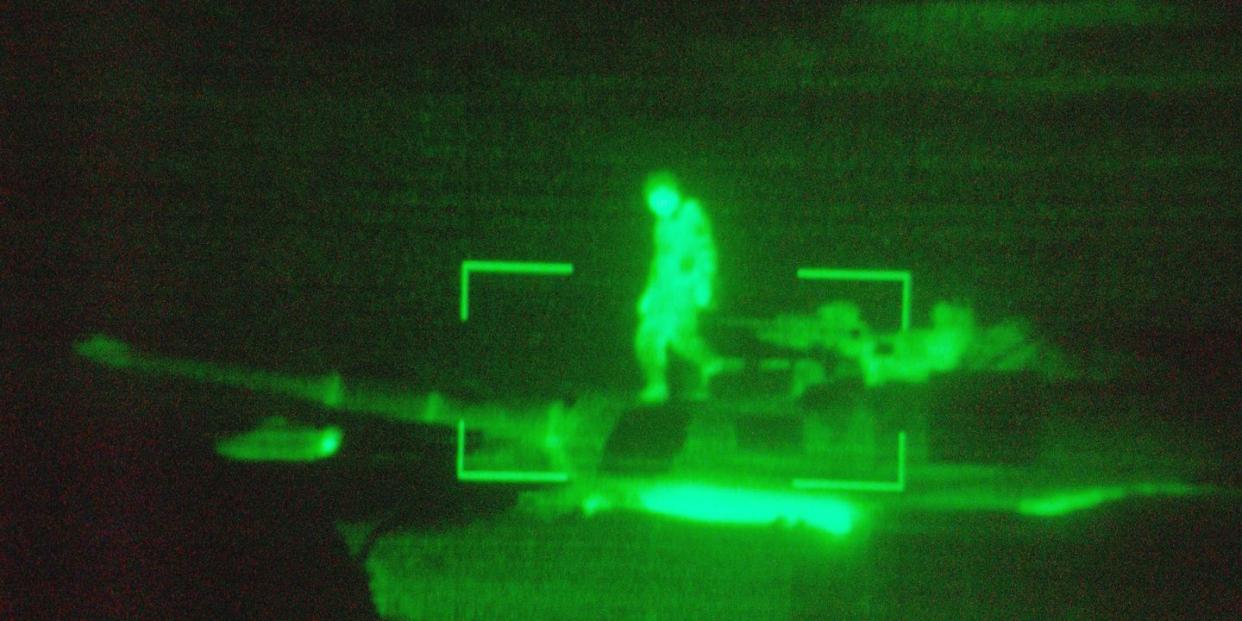Russian Troops Figured Out How to Make Themselves Invisible

"Hearst Magazines and Yahoo may earn commission or revenue on some items through these links."
There are probably few things as terrifying as being hunted at night by a foe who can see in the dark—especially when you can’t. It can leave exposed personnel at the mercy of distant snipers, armored vehicles, or even tiny grenade-armed drones hovering overhead.
This is a common situation for Russian troops invading Ukraine, as they are comparatively under-supplied with night-vision systems. To reduce the ease with which thermal-imaging-equipped Ukrainian drones and snipers can detect them, a recent report indicates that Russian troops are turning to mylar ponchos, or ‘space blankets’, to cloak their heat signatures.
A Ukrainian officer deployed to Eastern Ukraine—going by the social media handle Tatarigami—claims this trend has been observed amongst Russian troops. In particular, such blankets were identified on Russian troops captured or killed near Avdiivka, immediately north of the large city of Donetsk in Eastern Ukraine.
2/ According to the information provided by our soldiers, russian sabotage groups (DRGs) are reportedly using these anti-thermal blankets/coats to avoid detection by thermal cameras and UAV's. pic.twitter.com/VBwr6uKrQU
— Tatarigami_UA (@Tatarigami_UA) April 24, 2023
“According to the information provided by our soldiers, Russian sabotage groups (DRGs) are reportedly using these anti-thermal blankets/coats to avoid detection by thermal cameras and UAV’s [drones],” he writes in a Twitter thread. “A video previously published on a Russian Telegram channel allegedly demonstrates the effectiveness of the product, displaying how a soldier can remain undetected under the anti-thermal blanket.”
It’s far from the newest trick in the book. Military vehicles are often sold with camouflage tarps incorporating thermal signature-reduction methods. The Taliban in Afghanistan was known to effectively use ‘space blankets’ to reduce odds of detection by NATO forces. And pro-Ukraine volunteers in the war have also solicited such blankets for personnel camouflage. A Ukrainian inventor has even patented an IR-masking cloak.
For that matter, some space blankets or tents are advertised on the commercial market for their heat-signature masking properties—you know, just in case you find yourself hunted in the wild by the The Predator.
The results aren’t perfect. The blankets do still betray a somewhat blotchy contour on thermal imagers.
Still, they stand out far less than a regularly clothed human body, and are undoubtedly much harder to pick out while making a broader area scan. The technique may also be more effective against lower-quality or shorter-range commercial thermal imagers.
Mylar—also known by trade names Melinex and Hostaphan and the scientific term BoPET—is usually most valued for its ability to prevent heat loss. That too is a relevant quality, as earlier in the winter of 2022/2023, drone cameras recorded footage of under-equipped Russian soldiers on the frontline freezing to death or incapacitated by hypothermia. Quite a few such blankets or ponchos have been issued to refugees in Ukraine and beyond.

But mylar also reflects 97 percent of radiated heat, greatly shielding the wearer from infrared sights.
The Night Vision Gap
Russia’s calamitous war in Ukraine has illuminated a long-known weakness in the country’s military—a relative deficit in infrared night-vision devices to outfit its troops and vehicles. There simply aren’t enough to go around—especially for infantry on foot—and they are of lower quality than those used by Western militaries.
Until recently, for example, Russia’s most modern tanks relied on an infrared sight by French company Thales called the Catherine FC. The country lost access to those after its first invasion of Ukraine in 2014. Since then, Russia had to begin assembling its own devices, a process made much more difficult by the fact than many sources of necessary components are under sanction. Some older Russian vehicles still rely on active infrared searchlights, which light up the vehicles using them with potentially fatal results.
Meanwhile, U.S. military assistance to Ukraine has focused on provision of night vision equipment goggles, particularly prior to Russia’s 2022 invasion, when transfers of lethal weapons were rare. Thus, Ukrainian troops have demonstrated an overall edge in night combat, though they too need more night-vision systems. Such equipment can be lethally effective for picking out concealed troops and vehicles.
One of the reasons I’m skeptical when people say the tank is obsolete is that technological advances, such as in thermal optics, UAVs, more accurate and longer range artillery and machine guns, have also made light vehicles and infantry more vulnerable.https://t.co/Kg0yEqDMuW pic.twitter.com/3nAOJmNPRr
— Rob Lee (@RALee85) March 24, 2023
Even though the signature masking offered by ‘space’ blankets and coats is hardly perfect, it could still mean the difference between life and death if it occasionally succeeds at preventing someone from being spotted by an overhead drone or distant sniper.
Tatarigami, however, thinks Russia’s adoption of this technology will be limited in scope: “It is doubtful that the enemy can supply these anti-thermal blankets/coats on a significant scale. Nonetheless, even if they can only be utilized by small groups or sniper teams, they still pose a potential threat.”
As thermal sensors become even more ubiquitous on modern battlefields, it follows that forward-looking militaries may be compelled to more systematically evaluate personal thermal camouflage and, if it’s found sufficiently effective, integrate it alongside optical camouflage measures. Past efforts to introduce thermal camouflage fell short of a slam dunk, but the technology may have matured since.
You Might Also Like

